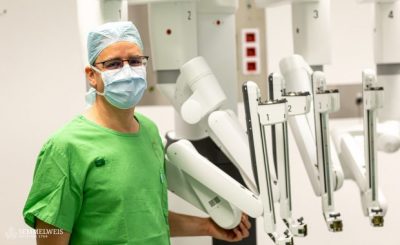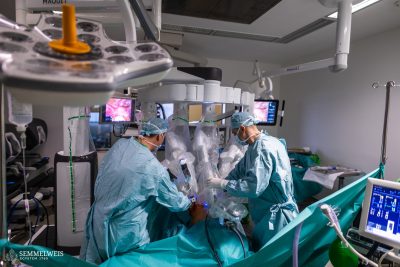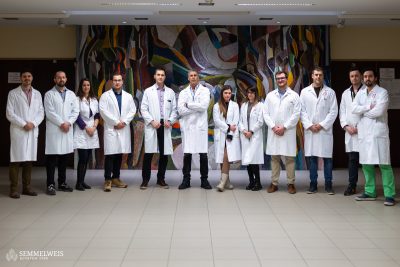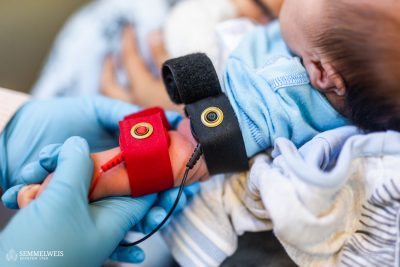Not even a year has passed since the da Vinci Xi robotic surgical instrument arrived at Semmelweis University in August 2021 for a two-day demonstration, which was then tested by the staff and students of the University’s 1st Department of Surgery (now the Department of Surgery and Interventional Gastroenterology). Nine months later, the university’s own instrument was put into operation at the clinic and the first surgery was performed on 24 May, followed by two more robot-guided operations the next day. The first patient could leave the clinic on the second day after the surgery, and she is doing well.

“While the range of motion of the human wrist is limited, the da Vinci system can move its robotic arms up to 520 degrees, allowing it to reach places and make small movements that a surgeon could perform neither with his bare hands nor with a laparoscope during an open operation,” says Professor Dr. Attila Szijártó, who performed the first operations.
As the Director of the Department of Surgery and Interventional Gastroenterology explains, the system consists of three main parts: a robotic arm with four arms is in contact with the patient, and the doctor does not stand next to the patient, but sitting at the surgical console he communicates with the robot, controls it with pedals and joystick-like arms. The technology allows the surgeon to see the surgical site in three dimensions and at least ten times magnification.
The third pillar of the da Vinci system is the so-called tower, which allows medical students or colleagues who want to learn the new procedure to see the movement of the robotic arms, and also contains the important instruments that ensure the safety of the surgery, for example, control bleeding.
In the future, complex oncological diseases will be surgically treated with this device. I would compare robot-driven technology to someone who can drive a car and then learns to fly a plane, opening up new dimensions in 3D. – Dr. Attila Szijártó
In Hungary, two institutions already have a previous generation technology (DaVinci X), but Semmelweis University is a pioneer in the field of abdominal surgery and in the launch of a complex robotic surgery program that includes education, research and treatment.
The DaVinci Xi robot was also visited by Dr. Béla Merkely, Rector, Dr. Lívia Pavlik, Chancellor and Dr. Attila Szabó, Vice-Rector for Clinical Affairs.
The fourth-generation robot (DaVinci Xi) at the clinic, with the most advanced technological background known today – two surgical consoles enabling also education and training – is able to ensure the treatment of patients, the training of medical students and young specialists at the best university in Central and Eastern Europe, while also helping to ensure the effectiveness of clinical research, added Dr. Béla Merkely.
According to the Rector of Semmelweis University, this latest technology opens up new horizons not only for surgeon colleagues, but also for future doctors, as it is inevitable that robotic technology will be included in the undergraduate and graduate training of doctors in the next 30-40 years. Of course, this does not mean that everyone will operate with robots, but it is a great opportunity for surgery and other disciplines alike.
“With the state-of-the-art technology currently available, surgeons can perform surgery more precisely and accurately, patients can expect less surgical stress, shorter hospital stays and faster recovery, so overall we can do more for patients and be more scientifically effective. What lies ahead is to build a larger professional staff skilled in robotic surgery, and to practice, research and teach the full spectrum of robotic surgery at Semmelweis University. We expect to be able to perform about fifty new robotic surgeries by the summer,” the Rector added.
What lies ahead is to build a larger professional staff skilled in robotic surgery, and to practice, research and teach the full spectrum of robotic surgery at Semmelweis University. We expect to be able to perform about fifty new robotic surgeries by the summer,” the Rector added.
In the future, the new system will be used at the clinic about 400 times a year, in addition to general surgery, in gynecological, urological and otolaryngological interventions, with the funding of the National Health Insurance Fund (NEAK) funding.
Ten surgeons are currently being trained to perform robotic surgery as part of the program, but as da Vinci will also play a significant role in education, future surgeons will be able to learn the new technology.
Orsolya Dávid
Translation: Gábor Kiss
Photo: Attila Kovács – Semmelweis University











